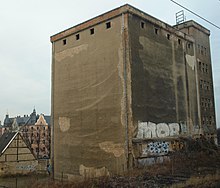Museum Hofmühle Dresden
The Museum Hofmühle Dresden is a mill technology and local history museum in the Saxon state capital.
Location
The Hofmühle Museum Dresden is located on the second to fourth floors of the corner building of the Bienertmühle Dresden-Plauen . This is located in the southwest of Dresden on the street front of the village center "Altplauen" in the Plauen district and is located directly to the east of the point where the Weißeritz enters the Elbe valley from the Plauen reason . The adjoining buildings were converted into apartment flats, the octagonal chimney, which is listed as a historical monument, has been preserved.
With the Münchner Platz Memorial , the Museum of the History of the Windberg Railway and the Railway Museum Dresden-Altstadt, there are other Dresden museums in the area.
Exhibitions
Several permanent exhibitions can be seen in the museum, including the Anton Reiche Museum, the Gret Palucca exhibition and exhibitions on mill technology and Plauen local history. Temporary exhibitions and events take place regularly in other rooms.
Anton Reiche Museum
The museum named after Friedrich Anton Reiche is one of the world's largest publicly displayed collections of historical chocolate shapes and artistically valuable tin cans. The exhibits date from 1870 to the beginning of the 20th century and were made available on permanent loan by Reich 's great-granddaughter, who lives in Vienna . Reiches company, founded in 1870, developed in what was then the food and luxury food industry center of Dresden into Europe's largest producer of baking and chocolate molds. Among other things, over 1,500 chocolate molds and more than 100 decorative tin boxes are on display.
Palucca - Biographical information in suitcases
This exhibition deals with the life and work of the dancer and dance teacher Gret Palucca . She was the wife of Ida Bienert's son Friedrich , the mill owner in the third Bienert generation. The exhibition was conceived in 2002 and came to the Hofmühle on permanent loan from the Palucca School Dresden . It was opened on September 8, 2007 on the third floor of the building. Various stations from Palucca's work can be seen in seven large, opened suitcases that are based on Palucca's touring suitcases. The University of Dance founded by Palucca in 1925 is still the only one of its kind in Germany.
Local history of Dresden-Plauen and mill technology
Local historical exhibits from Plauen are also presented . Topics are the work of Gottlieb Traugott Bienert and his descendants, the history of the Plauen reason and in particular the history of the Hofmühle itself. The heart of the museum is the historical mill and transmission technology from the early 20th century. These are mixing plants that are still in their original places.
history
It already existed as a grinding mill in the 13th century and is said to be one of the oldest mills in Saxony. From 1295 it belonged to the Dresden Cloth Makers' Guild and was converted into a fulling mill. Acquired by Elector August in 1568 , it was replaced by a larger new building and thus became the Dresden Hofmühle, in which grinding was compulsory for Dresden and 66 villages in the area until the 19th century . After its abolition, it was leased, expanded, modernized and finally purchased by Gottlieb Traugott Bienert in 1852. Around 1900, 269 workers were employed in the company, and in 1913 the new Dresden mill was opened . In the time of the GDR , the nationalization and the cessation of the mill, from which a baked goods factory emerged. In 1992 this company, which last belonged to Fleming + Wendeln , also had to close.
On June 24, 2005, the "Hofmühle Foundation Dresden" was founded, the sponsor of today's museum. She developed the ideas for the preservation and use of the former sales, residential and operational building of the Hofmühle, which was built in 1878 and is a listed building. A (partial) renovation of the building took place in 2005 and 2006 while largely preserving the original structure. The museum finally opened in July 2006. The rooms of the former factory shop on the ground floor have since been used for events under the name "Bienerts Laden".
Music is also performed in the Hofmühle. She is a member of the KlangNetz Dresden .
The storehouse of the former mill, which characterizes the location, was demolished in January 2010 by its owner, the German Alpine Association, as, according to its statements, no funding could be made available for the integration of the structure into a newly planned climbing center.
literature
- T. Bienert steam mill u. Oil factory, Hofmühle Dresden-Plauen. Establishment of the business: May 1st, 1852. Dresden 1897 ( digitized version )
- As a reminder of the visit to the Hofmühle zu Plauen-Dr. by Se. Maj.King Friedrich August on March 16, 1905 ( digitized version )
- Adolf Hantzsch: On the history of the court mill in Plauen near Dresden. Dresden History Papers 1901, No. 2
- Th. Schäfer: Dresden's surroundings. 70 full and half day excursions to the left of the Elbe. 3rd edition, Meinhold Dresden 1892.
Web links
- Museum website
- Information on the mill at the Dresden mill database ( Memento from May 28, 2016 in the Internet Archive )
- Museum Hofmühle Dresden on dresden.de
- dresdner-stadtteile.de
- Hofmühle on Stadtwiki Dresden
Coordinates: 51 ° 1 ′ 48.5 ″ N , 13 ° 42 ′ 8 ″ E


